699 Search Results for communication book
June 17, 2018
by Carole Zangari -
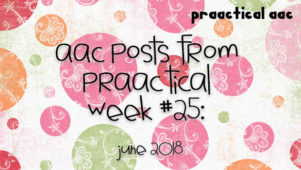
Happy Sunday, AAC friends. We’re celebrating Father’s Day here in the US but if you have time to catch up on a little AAC, you might be interested in a few of our posts from last week. Monday – AAC Assessment Corner with Vicki Clarke: Evaluating Skills For Use of Comprehensive AAC Systems, Part 2: Language Representation Elements – Noun Symbol Use for Functional Communication Tuesday – AAC Link Up Wednesday – Video of the Week: AAC in Emergency Situations – Tales from the Trenches Thursday – PrAACtical Resources: Core Vocabulary Flipbook for June Words :::::::::::::::::::::::::::::::::::::::::::::::::::::::::::::::::::::::::::::::::::::::::::::::::::::::::::::::: We spent part of the week with Dr. Caroline Musselwhite who shared some wonderful ideas for teaching emergent to early conventional literacy skills. Her terrific workshop got us in the mood for a little more on AAC, reading, and writing. Using an Alphabet Flipbook for Writing Writing Instruction for Students with Angelman Syndrome Robust Literacy Instruction for... [Read More...]
May 31, 2018
by Carole Zangari -
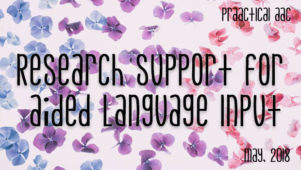
Aided language input, the practice of modeling AAC when speaking to those who are trying to learn AAC, is a pivotal intervention strategy. It has been shown to support comprehension and expression, and the development of early sentence forms. The evidence suggests it may also support the development of certain grammatical morphemes and verb combinations. You can learn more about the implementation of aided language input here. Here are some of the research studies that support the use of this evidence-based practice. Binger, C., & Light, J. (2007). The effect of aided AAC modeling on the expression of multi-symbol messages by preschoolers who use AAC. Augmentative and Alternative Communication, 23, 30–43. Binger, C., Maguire-Marshall, M., & Kent-Walsh, J. (2011). Using aided AAC models, recasts and contrastive targets to teach grammatical morphemes to children who use AAC. Journal of Speech, Language and Hearing Research, 54, 160–176. Dada, S., & Alant, E. (2009). The... [Read More...]
May 10, 2018
by Carole Zangari -
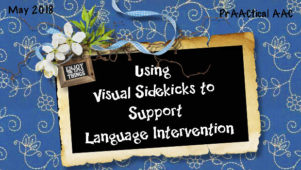
SLPs Lori Sanzeri and Chelsea Collins, creators of Core City, are back to share ideas for implementing AAC in the classroom. Today, they share their experiences in using visual supports as a supplemental strategy for their students who are beginning to use AAC. Enjoy! ::::::::::::::::::::::::::::::::::::::::::::::::::::::::::::::::::: Using Visual Sidekicks to Support Language Intervention Have you ever tried to read a book to your students without providing any visual supports? Do you find yourself having difficulty thinking about what questions to ask? Do you ever feel like the story is too “wordy” or difficult for your students to understand? Have no fear, Visual Sidekicks are here! Visual Sidekicks provide a color-coded communication board of target core and fringe vocabulary along with sentences of 3-5 symbols that simplify the text throughout the story. Children with special needs often demonstrate difficulties during structured literacy activities in the following areas: attending to... [Read More...]
May 7, 2018
by Carole Zangari -
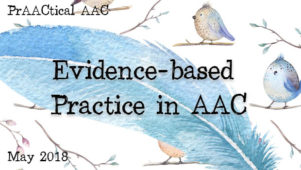
Dr. Jill Senner and Matthew Baud are staunch advocates for using research-based strategies and other evidence-based practices (EBP) in their AAC work. In today’s post. they share their thoughts on what EBP is, why it is important for AAC professionals, and how to incorporate it into our clinical and educational practices. :::::::::::::::::::::::::::::::::::::::::::::::::::::::::::::::::::::::::::::::::::::: Facts Matter: EBP in AAC Evidence-based practice (EBP) has been a buzz word in healthcare and education for almost two decades. However, “it has been well documented in many disciplines that major gaps exist between what is known as effective practices (i.e., theory and science) and what is actually done (i.e., policy and practice)” (Fixsen et al., 2005, p. 2). What is EBP, why is it important and how can we make sure we’re incorporating evidenced-based practices into our work with students and clients using AAC? Let’s take a look at answers to each of these questions below.... [Read More...]
May 3, 2018
by Carole Zangari -
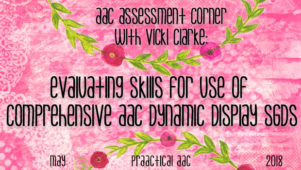
We’re always thrilled to share a guest post on AAC assessment practices from Vicki Clarke of Dynamic Therapy Associates. If you have questions about conducting AAC evaluations, read on. You can view her previous contributions to the AAC Assessment Corner here. :::::::::::::::::::::::::::::::::::::::::::::::::::::::::::::::::::::::::::::::::::: Evaluating Skills for Use of Comprehensive AAC Dynamic Display Systems Part I: Early Skills Over the past few years there has been an on-going discussion in the speech language pathology world about whether or not we needed to designate an official “specialty” recognition for augmentative and alternative communication practitioners. The argument goes something like this: It takes a lot of extra training, concerted effort in continuing education and daily practice in the assessment and implementation of augmentative communication to do it well. Therefore, we should have a “specialty area” in our national organization, ASHA, devoted to AAC. The counter-argument states that if our governing body says you need to... [Read More...]
April 23, 2018
by Carole Zangari -
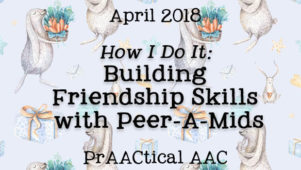
Many of our AAC learners need help building the knowledge and skills that are important when trying to connect with others and develop true friendships. In this post, SLP Katie Bernadkin shares one approach that she uses with her students. Katie is a New York City native now working in San Diego middle and elementary schools. She focuses on autism, AAC, and social cognition. In this post, she explains how uses Social Thinking’s Peer-A-Mid concept to support her students. :::::::::::::::::::::::::::::::::::::::::::::::::::::::::::::::::::::::: Building a Peer-a-mid Do you have any kids on your caseload that have a hard time recognizing when other kids are attempting to befriend them? Conversely, do you know the student who seems to always end up with a “friendly” peer, who is daring them to say something naughty? Recognizing these signs is such a valuable skill for our socially challenged kids to learn. I like to start with the... [Read More...]
April 16, 2018
by Carole Zangari -
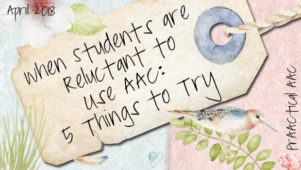
Work with students who are reluctant to use their AAC in front of others? Sometimes students become self-conscious and hesitate to use SGDs or other forms of AAC out of the fear that it will make them stick out. Of course, we do our best to encourage them but what else can we do? Here are a few things to try. Normalize AAC use: When lots of people use AAC, it reduces the student’s feeling that they stick out. Be relentless in your own modeling, and help others to build the habit of using AAC when they speak. Connect them with an AAC mentor: Role models can have a powerful influence on our perception of our world and ourselves. Connect students to others who use AAC successfully. If there aren’t older students or adults in your community, consider making online connections using social media. There are quite a few people... [Read More...]
March 25, 2018
by Carole Zangari -
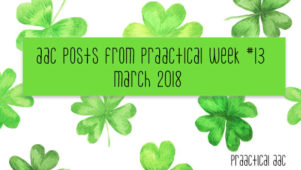
Missed some of our AAC posts from last week? Here’s what we were up to. Monday – PrAACtical Resources: Pragmatic Profile for People Who Use AAC Tuesday – AAC Link Up Wednesday – Video of the Week: Feature Matching for Apps Thursday – PrAACtical Alert: AAC App Discounts :::::::::::::::::::::::::::::::::::::::::::::::::::::::: Looking for some resources to use in your AAC work? Check out some of those listed below. AAC 101 Flipbook Communication Partner Data Collection Form AAC Skills: Caught or Taught? AAC Modeling Handout Repairing Communication Breakdowns
March 18, 2018
by Carole Zangari -
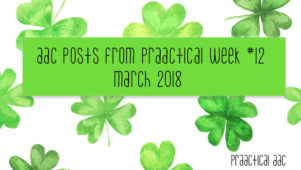
Happy Sunday, AAC friends! Here are a few past posts to start your day. Monday – PrAACtical Alert: AAC Professional Development Options Tuesday – AAC Link Up Wednesday – Video of the Week: Medicaid Funding for SGDs Thursday – Transitioning to the Workplace: Resources for AAC Learners with Significant Disabilities ::::::::::::::::::::::::::::::::::::::::::::::::::::::::::::::::::::::::::::: Looking for some AAC materials? We pulled out a few from the AAC Toolbox just for you. Spelling Boards & FlipBook– Letter boards (alpha & QWERTY) used at Camp Alec; Created by Tina Moreno Visual Supports Wiki Resources from OCPS – See also How We Do It: Essential TRICKs for Supporting AAC in Schools, Part 1 How I Communicate – Template for a Gesture Dictionary Communicare Language Board Templates – Communication board templates for the post “How We Do It: Using Language Boards to Support AAC Use” Colorful Connections – Templates for teaching modified Fitzgerald Key and Goossens’, Crain, & Elder color-coding schemas
March 12, 2018
by Carole Zangari -
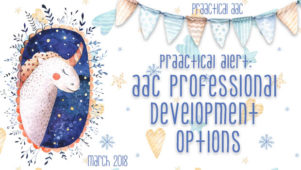
Lauren Enders, an amazing AAC SLP from Pennsylvania, graciously shared this list of professional development opportunities that may be of interest. Lauren works as an Augmentative Communication/Assistive Technology Consultant for Bucks County Intermediate Unit #22. In the list below, she shares resources for AAC learning in both online and face-to-face formats. Enjoy! You can see more of Lauren’s guest posts here. PROFESSIONAL DEVELOPMENT OPTIONS FOR AAC IMPLEMENTATION ONLINE SELF-DIRECTED LEARNING OPTIONS: Power AAC modules: a FREE training series developed by The Pennsylvania Training and Technical Assistance Network (PaTTAN)with Gail Van Tatenhove, CCC-SLP. This series of brief modules can be used for professional development by individuals or groups who are supporting students with complex communication needs and who need or use AAC. The POWER AAC modules are intended to build the capacity of school personnel to improve communication skills and provide flexible, generative vocabulary for students who need or use AAC. AAC Institute... [Read More...]









